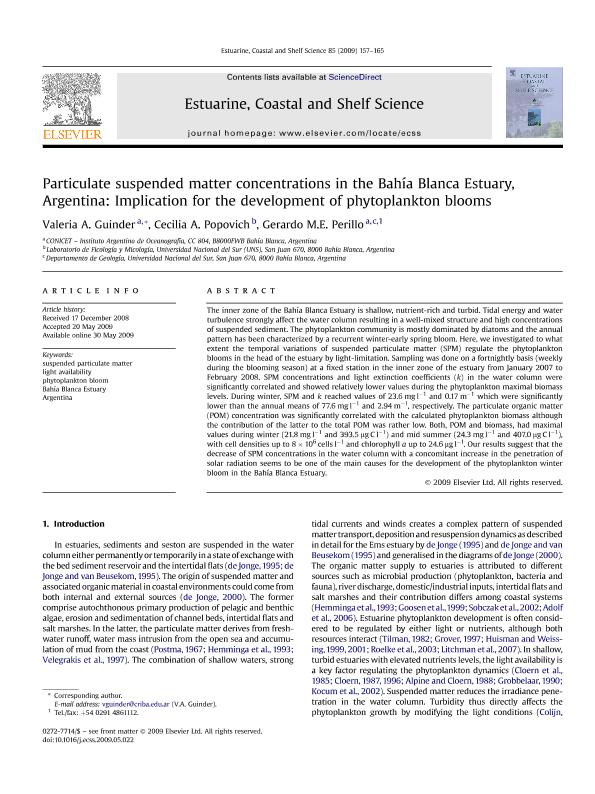Mostrar el registro sencillo del ítem
dc.contributor.author
Guinder, Valeria Ana

dc.contributor.author
Popovich, Cecilia Angelines

dc.contributor.author
Perillo, Gerardo Miguel E.

dc.date.available
2018-08-21T15:07:19Z
dc.date.issued
2009-10
dc.identifier.citation
Guinder, Valeria Ana; Popovich, Cecilia Angelines; Perillo, Gerardo Miguel E.; Particulate suspended matter concentrations in the Bahía Blanca Estuary, Argentina: Implication for the development of phytoplankton blooms; Academic Press Ltd - Elsevier Science Ltd; Estuarine, Coastal and Shelf Science; 85; 1; 10-2009; 157-165
dc.identifier.issn
0272-7714
dc.identifier.uri
http://hdl.handle.net/11336/56317
dc.description.abstract
The inner zone of the Bahía Blanca Estuary is shallow, nutrient-rich and turbid. Tidal energy and water turbulence strongly affect the water column resulting in a well-mixed structure and high concentrations of suspended sediment. The phytoplankton community is mostly dominated by diatoms and the annual pattern has been characterized by a recurrent winter-early spring bloom. Here, we investigated to what extent the temporal variations of suspended particulate matter (SPM) regulate the phytoplankton blooms in the head of the estuary by light-limitation. Sampling was done on a fortnightly basis (weekly during the blooming season) at a fixed station in the inner zone of the estuary from January 2007 to February 2008. SPM concentrations and light extinction coefficients (k) in the water column were significantly correlated and showed relatively lower values during the phytoplankton maximal biomass levels. During winter, SPM and k reached values of 23.6 mg l-1 and 0.17 m-1 which were significantly lower than the annual means of 77.6 mg l-1 and 2.94 m-1, respectively. The particulate organic matter (POM) concentration was significantly correlated with the calculated phytoplankton biomass although the contribution of the latter to the total POM was rather low. Both, POM and biomass, had maximal values during winter (21.8 mg l-1 and 393.5 μg C l-1) and mid summer (24.3 mg l-1 and 407.0 μg C l-1), with cell densities up to 8 × 106 cells l-1 and chlorophyll a up to 24.6 μg l-1. Our results suggest that the decrease of SPM concentrations in the water column with a concomitant increase in the penetration of solar radiation seems to be one of the main causes for the development of the phytoplankton winter bloom in the Bahía Blanca Estuary.
dc.format
application/pdf
dc.language.iso
eng
dc.publisher
Academic Press Ltd - Elsevier Science Ltd

dc.rights
info:eu-repo/semantics/openAccess
dc.rights.uri
https://creativecommons.org/licenses/by-nc-nd/2.5/ar/
dc.subject
Argentina
dc.subject
Bahía Blanca Estuary
dc.subject
Light Availability
dc.subject
Phytoplankton Bloom
dc.subject
Suspended Particulate Matter
dc.subject.classification
Meteorología y Ciencias Atmosféricas

dc.subject.classification
Ciencias de la Tierra y relacionadas con el Medio Ambiente

dc.subject.classification
CIENCIAS NATURALES Y EXACTAS

dc.title
Particulate suspended matter concentrations in the Bahía Blanca Estuary, Argentina: Implication for the development of phytoplankton blooms
dc.type
info:eu-repo/semantics/article
dc.type
info:ar-repo/semantics/artículo
dc.type
info:eu-repo/semantics/publishedVersion
dc.date.updated
2018-07-11T14:17:49Z
dc.journal.volume
85
dc.journal.number
1
dc.journal.pagination
157-165
dc.journal.pais
Países Bajos

dc.journal.ciudad
Amsterdam
dc.description.fil
Fil: Guinder, Valeria Ana. Consejo Nacional de Investigaciones Científicas y Técnicas. Centro Científico Tecnológico Conicet - Bahía Blanca. Instituto Argentino de Oceanografía. Universidad Nacional del Sur. Instituto Argentino de Oceanografía; Argentina
dc.description.fil
Fil: Popovich, Cecilia Angelines. Universidad Nacional del Sur. Departamento de Biología, Bioquímica y Farmacia. Laboratorio de Ficología y Micología; Argentina. Consejo Nacional de Investigaciones Científicas y Técnicas; Argentina
dc.description.fil
Fil: Perillo, Gerardo Miguel E.. Consejo Nacional de Investigaciones Científicas y Técnicas. Centro Científico Tecnológico Conicet - Bahía Blanca. Instituto Argentino de Oceanografía. Universidad Nacional del Sur. Instituto Argentino de Oceanografía; Argentina
dc.journal.title
Estuarine, Coastal and Shelf Science

dc.relation.alternativeid
info:eu-repo/semantics/altIdentifier/doi/http://dx.doi.org/10.1016/j.ecss.2009.05.022
dc.relation.alternativeid
info:eu-repo/semantics/altIdentifier/url/https://www.sciencedirect.com/science/article/pii/S0272771409002595
Archivos asociados
